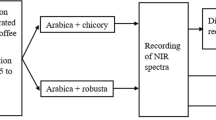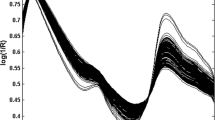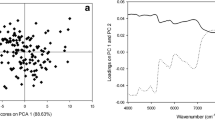Abstract
In this work, a methodology based on near-infrared spectroscopy (NIRS) was exploited in order to discriminate between commercial coffee brands. The main advantages of this approach compared to other strategies (e.g., wet chemistry methods) are its lower cost, less labor, and lower time per analysis. Two commercial brands were discriminated among several others present in the Portuguese market. The chemometric method used to estimate discriminant models was partial least squares discriminant analysis (PLSDA). Results show that it is possible to discriminate coffee brands using this strategy with a correct classification of 100 %. The spectral region, more favorable to discrimination of roasted coffee brands, can be related with differences in the concentrations of compounds, such as, chlorogenic acid and sucrose, and also due to differences on lipid fraction. This methodology is adequate for field implementation, namely, adopting handheld NIRS instruments.






Similar content being viewed by others
References
Barker M, Rayens W (2003) Partial least squares for discrimination. J Chemom 17:166–173
Burns DA, Ciurczak EW (eds) (2008) Handbook of near-infrared analysis, vol 35. Pratical spectroscopy, 3rd edn. Taylor and Francis, New York
Coutinho CP, Sá-Correia I, Lopes JA (2009) Use of Fourier transform infrared spectroscopy and chemometrics to discriminate clinical isolates of bacteria of the Burkholderia cepacia complex from different species and ribopatterns. Anal Bioanal Chem 394:2161–2171
Downey G, Boussion J (1996) Authentication of coffee bean variety by near-infrared reflectance spectroscopy of dried extract. J Sci Food Agric 71:41–49
Downey G, Boussion J, Beauchêne D (1994) Authentication of whole and ground coffee beans by near infrared reflectance spectroscopy. J Near Infrared Spectrosc 2:85–92
Esteban-Diez I, Gonzalez-Saiz JM, Pizarro C (2004) An evaluation of orthogonal signal correction methods for the characterisation of arabica and robusta coffee varieties by NIRS. Anal Chim Acta 514:57–67
Esteban-Diez I, Gonzalez-Saiz JM, Saenz-Gonzalez C, Pizarro C (2007) Coffee varietal differentiation based on near infrared spectroscopy. Talanta 71:221–229
Gardner JW, Shurmer HV, Tan TT (1992) Application of an electronic nose to the discrimination of coffees. Sensors Actuators B Chem 6:71–75
Gonzalez AG, Pablos F, Martin MJ, Leon-Camacho M, Valdenebro MS (2001) HPLC analysis of tocopherols and triglycerides in coffee and their use as authentication parameters. Food Chem 73:93–101
International Coffee Organization (2011) Monthly coffee market report. November 2011
Kasemsumran S, Kang N, Christy A, Ozaki Y (2005) Partial least squares processing of near-infrared spectra for discrimination and quantification of adulterated olive oils. Spectrosc Lett 38:839–851
Kemsley EK, Ruault S, Wilson RH (1995) Discrimination between Coffea arabica and Coffea canephora variant robusta beans using infrared-spectroscopy. Food Chem 54:321–326
Lee JH, Choung MG (2011) Nondestructive determination of herbicide-resistant genetically modified soybean seeds using near-infrared reflectance spectroscopy. Food Chem 126:368–373
Martin MJ, Pablos F, Gonzalez AG (1996) Application of pattern recognition to the discrimination of roasted coffees. Anal Chim Acta 320:191–197
Martin MJ, Pablos F, Gonzalez AG (1999) Characterization of arabica and robusta roasted coffee varieties and mixture resolution according to their metal content. Food Chem 66:365–370
Menesatti P, Costa C, Paglia G, Pallottino F, D'Andrea S, Rimatori V, Aguzzi J (2008) Shape-based methodology for multivariate discrimination among Italian hazelnut cultivars. Biosyst Eng 101:417–424
Pardo M, Niederjaufner G, Benussi G, Comini E, Faglia G, Sberveglieri G, Holmberg M, Lundstrom I (2000) Data preprocessing enhances the classification of different brands of Espresso coffee with an electronic nose. Sensors Actuators B Chem 69:397–403
Pizarro C, Esteban-Diez I, Gonzalez-Saiz JM (2007) Mixture resolution according to the percentage of robusta variety in order to detect adulteration in roasted coffee by near infrared spectroscopy. Anal Chim Acta 585:266–276
Reich G (2005) Near-infrared spectroscopy and imaging: basic principles and pharmaceutical applications. Adv Drug Deliv Rev 57:1109–1143
Ruiz-Samblas C, Cuadros-Rodriguez L, Gonzalez-Casado A, Garcia FDR, de la Mata-Espinosa P, Bosque-Sendra JM (2011) Multivariate analysis of HT/GC-(IT)MS chromatographic profiles of triacylglycerol for classification of olive oil varieties. Anal Bioanal Chem 399:2093–2103
Salva TJG, Ribeiro JS, Ferreira MMC (2011) Chemometric models for the quantitative descriptive sensory analysis of Arabica coffee beverages using near infrared spectroscopy. Talanta 83:1352–1358
Wold S, Albano C, Dunn WJ III, Edlund U, Esbensen K, Geladi P, Hellberg S, Johansson E, Lindberg W, Sjostrom M (1984) In: Kowalski BR (ed) Chemometrics, mathematics and statistics in chemistry. D. Reidel, Dordrecht
Zambonin CG, Balest L, De Benedetto GE, Palmisano F (2005) Solid-phase microextraction–gas chromatography mass spectrometry and multivariate analysis for the characterization of roasted coffees. Talanta 66:261–265
Acknowledgments
The authors are grateful to Tenco Cafés, Lda, Portugal, for the helpful discussion and collaboration. M.C. Sarraguça and J.R. Santos acknowledge grants SFRH/BPD/74788/2010 and SFRH/BPD/63492/2009, respectively, funded by POPH-QREN, FSE, and MCTES. J.A. Lopes thanks FSE and MCTES for the financial support through the POPH-QREN program. This work has also been supported by Fundaçãopara a Ciência e a Tecnologia through project nos. PEst-C/EQB/LA0006/2011 and PEst-OE/EQB/LA0016/2011.
Author information
Authors and Affiliations
Corresponding author
Rights and permissions
About this article
Cite this article
Sarraguça, M.C., Santos, J.R., Rangel, A.O.S.S. et al. Authenticity Control of Roasted Coffee Brands Using Near-Infrared Spectroscopy. Food Anal. Methods 6, 892–899 (2013). https://doi.org/10.1007/s12161-012-9499-y
Received:
Accepted:
Published:
Issue Date:
DOI: https://doi.org/10.1007/s12161-012-9499-y




